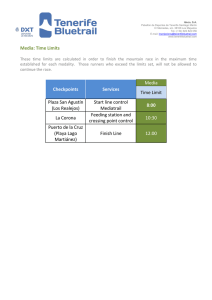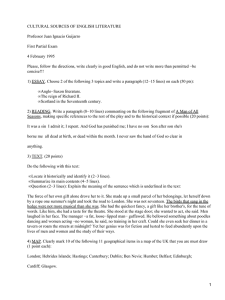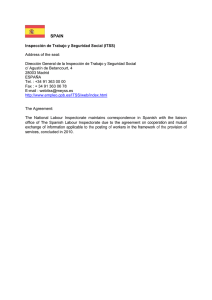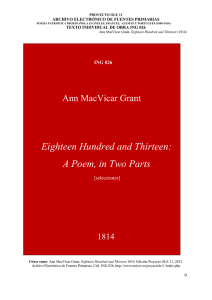Hierarchical objects Task force - Case study template
Anuncio
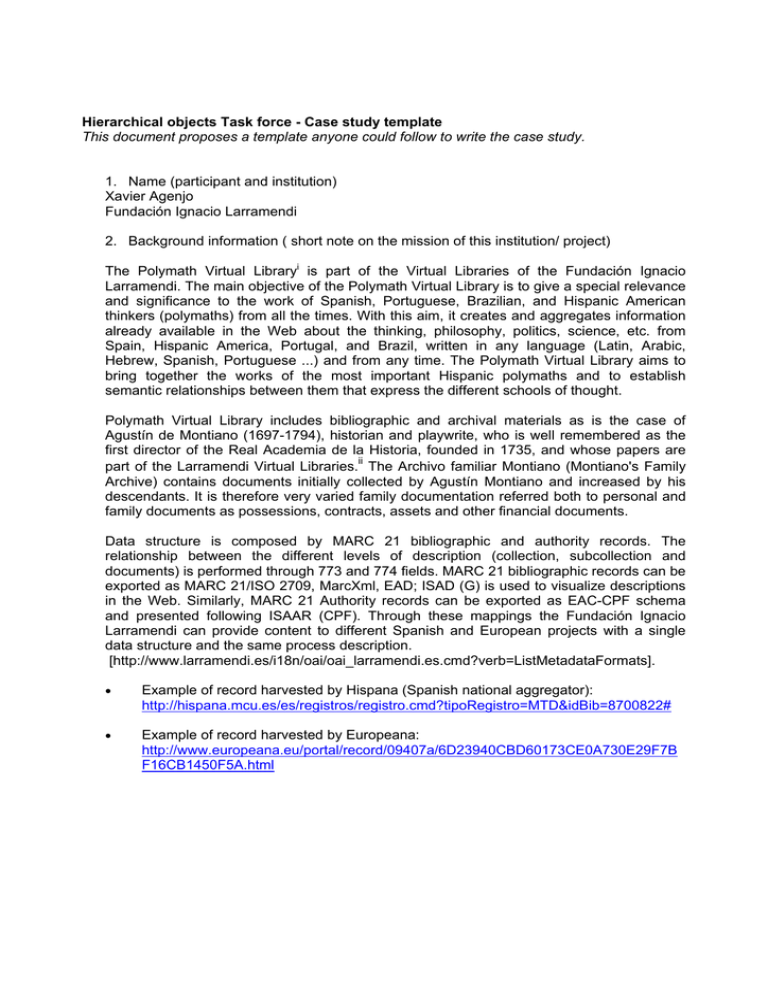
Hierarchical objects Task force - Case study template This document proposes a template anyone could follow to write the case study. 1. Name (participant and institution) Xavier Agenjo Fundación Ignacio Larramendi 2. Background information ( short note on the mission of this institution/ project) The Polymath Virtual Libraryi is part of the Virtual Libraries of the Fundación Ignacio Larramendi. The main objective of the Polymath Virtual Library is to give a special relevance and significance to the work of Spanish, Portuguese, Brazilian, and Hispanic American thinkers (polymaths) from all the times. With this aim, it creates and aggregates information already available in the Web about the thinking, philosophy, politics, science, etc. from Spain, Hispanic America, Portugal, and Brazil, written in any language (Latin, Arabic, Hebrew, Spanish, Portuguese ...) and from any time. The Polymath Virtual Library aims to bring together the works of the most important Hispanic polymaths and to establish semantic relationships between them that express the different schools of thought. Polymath Virtual Library includes bibliographic and archival materials as is the case of Agustín de Montiano (1697-1794), historian and playwrite, who is well remembered as the first director of the Real Academia de la Historia, founded in 1735, and whose papers are ii part of the Larramendi Virtual Libraries. The Archivo familiar Montiano (Montiano's Family Archive) contains documents initially collected by Agustín Montiano and increased by his descendants. It is therefore very varied family documentation referred both to personal and family documents as possessions, contracts, assets and other financial documents. Data structure is composed by MARC 21 bibliographic and authority records. The relationship between the different levels of description (collection, subcollection and documents) is performed through 773 and 774 fields. MARC 21 bibliographic records can be exported as MARC 21/ISO 2709, MarcXml, EAD; ISAD (G) is used to visualize descriptions in the Web. Similarly, MARC 21 Authority records can be exported as EAC-CPF schema and presented following ISAAR (CPF). Through these mappings the Fundación Ignacio Larramendi can provide content to different Spanish and European projects with a single data structure and the same process description. [http://www.larramendi.es/i18n/oai/oai_larramendi.es.cmd?verb=ListMetadataFormats]. • Example of record harvested by Hispana (Spanish national aggregator): http://hispana.mcu.es/es/registros/registro.cmd?tipoRegistro=MTD&idBib=8700822# • Example of record harvested by Europeana: http://www.europeana.eu/portal/record/09407a/6D23940CBD60173CE0A730E29F7B F16CB1450F5A.html Other mappings from MARC 21 records allow that the Archivo Familiar Montiano could be harvested through its OAI repository in oai_dc, oai_marc, MarcXml, ESE and EDM (http://www.larramendi.es/i18n/oai/oai_larramendi.es.cmd?verb=ListMetadataFormats ). A detailed description of that practice can be read in Data Aggregation and Dissemination of Authority Records through Linked Open Data in a European Context [DOI:10.1080/01639374.2012.711441] Each description is identified by persistent identifiers and URIs that supports content negotiation http://www.larramendi.es/i18n/consulta/registro.cmd?id=3017 http://www.larramendi.es/bib/FIL20100017159 This case study can also be exemplified by the Archivo de la Imagen (see Description of specific example(s) of hierarchies) • El Archivo de la Imagen [Photographies Archive from Castilla-La Mancha] http://clip.jccm.es/archivo_de_la_imagen/i18n/micrositios/inicio.cmd Results in Europeana: http://www.europeana.eu/portal/search.html?query=europeana_dataProvider%3A%22 Archivo+de+la+Imagen+de+Castilla+La+Mancha%22 3. Definition of hierarchies for the domain Demonstrate how each domain defines hierarchies. Feel free to re-use definitions (e.g. RDA definition). Your description can be also illustrated by a diagram or graph using whatever tool you are comfortable with e.g. UML. iii Definition of the hierarchical model of descriptions in ISAD (G), Introduction I.8, p. 8 In Appendix A-1 one may find a hierarchical model of the levels of arrangement for the fonds and its constituent parts. There are levels of description, with differing degrees of detail, appropriate to each level of arrangement. For example, a fonds may be described as a whole in a single description or represented as a whole and in its parts at various levels of description. The fonds forms the broadest level of description; the parts form subsequent levels, whose description is often only meaningful when seen in the context of the description of the whole of the fonds. Thus, there may be a fonds-level description, a serieslevel description, a file-level description and/or an item-level description. Intermediate levels, such as a sub-fonds or sub-series, may be expected. Each of these levels may be further subdivided according to the complexity of the administrative structure and/or functions of the organization which generated the archival material and the organization of the material. In Appendix A-2 the model represents the complex relationships between creator(s) and the units of description, regardless of level, asexpressed in the boxes representing authority records according to ISAAR(CPF) and the links between them and the boxes representing the units of description of the fonds and its parts. Appendix B shows full examples of archival descriptions and some of its parts. Diagram (ISAD (G), Appendix A-1 The sum total of all descriptions thus obtained, linked in a hierarchy, as outlined in the model in the Appendix A-1, represents the fonds and those parts for which descriptions were made. For the purposes of these rules, this technique of description is called multilevel description. Note that hierarchical trees can be very different and that the presence of one concrete hierarchy doesn’t predefine the existence of lower or upper levels. For example, in this diagram Item can be in the tree Fonds-Series-File-Item and in Fonds-File-Item This is also shown by next diagram of the type of relationship "hierarchical whole-part" between documentary entities of several subtypes, when the series occupies the upper level of the hierarchy Taken from: Modelo Conceptual de Descripción Archivística y Requisitos de Datos Básicos de las Descripciones de Documentos de Archivo, Agentes y Funciones. Borrador final de la CNEDA (09-06-2011). http://www.mcu.es/archivos/docs/NEDA_MCDA_P1_P2_20110609.pdf CNEDA is the Conceptual Model of Archival Description and Requirements for Basic Data Descriptions of Archival Documents, Agents and Functions that is the National Spanish Standard for archival descriptions and that has been considered useful to show the variety of possible hierarchical trees. Use Case Scenario -Description of specific example(s) of hierarchies. The Archivo Familiar Montiano is a collection, it is a set of documents or documentary components from the same or different provenace gathered togheter for conservation reasons, for their special interest or any other criterion. At this moment the Archivo familiar Montiano has three levels of description: Collection, sub-collection and documentary unit. [Diagram of hierarchical relationship whole-part betwen documentary subtypes, when collections occupies the top level of the hierarchy. Also taken from the National Spanish Standard CNEDA] -Demonstrate how hierarchical objects are represented in a interface Search and retrieve: • Queries are made in all levels of descriptions. Each description is presented in records, each record representing a level of description. • Different levels of description are shown through the facet ‘belongs to’ (Pertenece a in the image) • At the moment, results are not categorize in a visible way to indicate the level of description, so users can´t select results by its level of description. However, records with digital copies associated have thumbnails. Collection description level Document description level Sub-collection description level Link to subcollection description Link to items Link to Collection description [From Archivo de la Imagen de la Junta de Comunidades de Castilla-La Mancha, Collection “Fondo Fotográfico de las Brigadas Internacionales”] Navigation: • Users can navigate to upper level descriptions, from the lower level to next upper level (but not from the upper to lower levels) Subcollection description level [http://www.larramendi.es/i18n/consulta/registro.cmd?id=3017] -Samples of data and solutions in EDM to represent them (these two point could be done at a later stage) <?xml version="1.0" encoding="UTF-8" ?> <rdf:RDF schemaLocation="http://www.w3.org/1999/02/22-rdf-syntax-ns# http://europeanalabs.eu/svn/europeana/trunk/ROOT/src/main/webapp/schemas/edm/EDM.xsd"> <ore:Aggregation about="http://www.larramendi.es/bib/FIL20100017159#aggregation"> <edm:aggregatedCHO resource="http://www.larramendi.es/bib/FIL20100017159" /> <edm:dataProvider>Fundación Ignacio Larramendi</edm:dataProvider> <edm:provider>Fundación Ignacio Larramendi</edm:provider> <edm:rights resource="http://creativecommons.org/publicdomain/mark/1.0/" /> <edm:isShownAt resource="http://www.larramendi.es/i18n/catalogo_imagenes/grupo.cmd?path=1001021" /> </ore:Aggregation> <edm:ProvidedCHO about="http://www.larramendi.es/bib/FIL20100017159"> <dcterms:alternative>Archivo Agustín Montiano. 07-13</dcterms:alternative> <dcterms:isPartOf resource="http://www.larramendi.es/bib/FIL20100016510" /> <dcterms:medium>online resource cr rdacarrier</dcterms:medium> <dc:title>Archivo Agustín Montiano. 07-13 [Recurso electrónico], 1850/04/21</dc:title> <dc:description>Alcance y contenido: Escritura de redención de dos censos perpetuos otorgada por Don Felix de la Sota y Sota y Don José Sanchez Puerta</dc:description> <dc:type>Manuscritos</dc:type> <dc:language>spa</dc:language> <dc:date>1850</dc:date> <dc:creator resource="http://www.larramendi.es/aut/FILA20110010324" /> <edm:type>TEXT</edm:type> </edm:ProvidedCHO> <edm:Agent about="http://www.larramendi.es/aut/FILA20110010324"> <skos:prefLabel lang="es">Montiano y Luyando, Agustín de (1697-1764)</skos:prefLabel> <skos:altLabel lang="es">Montiano y Luyando, Augustin</skos:altLabel> <skos:altLabel lang="es">Montiano y Luyando, Agustín de</skos:altLabel> <skos:altLabel lang="es">De Montiano y Luyando, Agustín (1697-1764)</skos:altLabel> <skos:altLabel lang="es">Luyando, Agustin de M. y (1697-1764)</skos:altLabel> <skos:altLabel lang="es">Luyando, Agustín de Montiano y (1697-1764)</skos:altLabel> <skos:altLabel lang="es">Luyando, Agustín de Montiano (1697-1764)</skos:altLabel> <skos:altLabel lang="es">Luyando, Augustin de M. y (1697-1764)</skos:altLabel> <skos:altLabel lang="es">Luyando, Augustin de Montiano y (1697-1764)</skos:altLabel> <skos:altLabel lang="es">Montiano y Luyando, Agustin de (1697-1764)</skos:altLabel> <skos:altLabel lang="es">Montiano y Luyando, Augustin de (1697-1764)</skos:altLabel> <skos:altLabel lang="es">Montiano y Luyando, Augustín Gabriel</skos:altLabel> <skos:note lang="es">El robo de Diana, 1701?</skos:note> <skos:note lang="es">Diccionario del teatro, 1997. - (Montiano y Luyando, Agustín de; n. Valladolid 1697, m. Madrid 1764)</skos:note> <skos:note lang="es">Cronología de la literatura española, siglos XVIII y XIX, 1992. - (Montiano y Luyando, Agustín de; El humilde; Domingo Luis de Guevara; Leghinto Dulichio)</skos:note> <skos:note lang="es">VIAF. - ID:53320851. http://viaf.org/viaf/53320851/#Montiano_y_Luyando,_Agust%C3%ADn_de_1697-1764</skos:note> <skos:note lang="es">Catálogo de Autoridades de la Biblioteca Nacional de España. Visitado el 28 de abril de 2011. - BNEXX930805</skos:note> <skos:note lang="es">Enciclopedia Universal Ilustrada Espasa. . - Escritor español. n. en Valladolid el 28 de febrero de 1697 y m. en Madrid el 1º de noviembre de 1764</skos:note> <skos:note lang="es">Library of Congress Authorities Catalog. Visitado el 28 de abril de 2011. - LC Control Number: n 90722233</skos:note> <skos:note lang="es">WorldCat Identities. Visitado el 28 de abril de 2011. http://www.worldcat.org/wcidentities/lccn-n90-722233</skos:note> <skos:note lang="es">Katalog der Deutschen Nationalbibliothek. Visitado el 28 de abril de 2011. - Span. Schriftsteller u. Historiker; Secretario de la cámara de Gracia y Justicia (1746); Begründer u. 1. Direktor der Real Academia de la Historia (1735) . - http://d-nb.info/gnd/138218072</skos:note> <skos:note lang="es">Historiador, crítico y dramaturgo. Primer director de la Real Academia de la Historia. Fue secretario de la cámara de Gracia y Justicia y secretario de Estado de Felipe V. Amigo y mentor de Nicolás Fernández de Moratín y colaborador del padre Martín Sarmiento, así como fundador y secretario de la Academia del Buen Gusto. Fundó la Real Academia de la Historia (1735) y fue su primer director (1738). Allí propuso trabajar en un Diccionario histórico-crítico de España para desterrar "las ficciones de las fábulas" y que a los acontecimientos se les diera "la más exacta cronología" con las "necesarias noticias geográficas antiguas y modernas". Fue también miembro de la Academia de la Arcadia de Roma bajo el nombre de Leghinto Dulichio. Junto con Ignacio de Luzán, Pedro Estala, y Leandro Fernández de Moratín, Agustín Montiano es uno de los principales teorizadores sobre el género dramático del siglo XVIII español; se fijó más en el teatro humanístico trágico del siglo XVI que en el del Siglo de Oro, aunque alude a la intensidad de los efectos dramáticos de Lope de Vega, Luis Vélez de Guevara y otros autores. Forma parte del movimiento neoclásico de la literatura española. Entre sus obras destacan: La lira de Orfeo, 1719; Cotejo de la conducta de S. M. con la del rey británico; Discurso sobre las tragedias españolas, 1750 -1753; Ataúlfo, 1750; Virginia, 1753; Égloga de Lisardo y Palemón; o El robo de Dina, 1727.</skos:note> <skos:note lang="es">Historiadores</skos:note> <skos:note lang="es">Críticos literarios</skos:note> <skos:note lang="es">Dramaturgos</skos:note> <rdaGr2:gender lang="en">male</rdaGr2:gender> <edm:begin>1697</edm:begin> <edm:end>1764</edm:end> </edm:Agent> </rdf:RDF> 4. Problems and limitations • Search and retrieval: Given the close dependency between the different description levels, all of them must be searchable in queries. Even, this is necessary since many times descriptions at lower levels contain only a date range or a name, that is clearly insufficient in the information provided to the user. Also it is very common in many descriptions at lower levels that present comparatively more data related to the archival process or administrative data than data of interest to users. • Presentación de resultados y navegación However, to present all descriptive levels has the problem of the usability of the interface. Often it is solved by means of hierarchical trees with all description levels, but also often this is not very usable. Could be replaced by rendering the different description levels in frames. Navigation between hierarchy differs in terms of usability. • From lower to the higher levels allow to complete information with descriptions in the upper levels. • Navigation from highest levels to lowest may not be effective in searching, but allows to explore a fonds, a series, a sub-series, etc. It has the difficulty that the number of results in lower levels can be hundreds. • In any case, it is necessary to link the units of a description level by the property edm:isNextinSequence. It can be used to navigate between the descriptions of the same level, especially among the lower levels that are linked to digital items. In EAD this is solved by nesting <c0..>, so all components of the same levels are in repeated <c02>, <c03>... Also it can be done by identifying the description level as proposed by Stefen iv Hennicke [et al.] Their URIs are constructed by concatenating the apenet namespace prefix, the resource type (aggregation-, cho-), the type of the EAD-level (archdesc, series, file, item), and a guaranteed unique identifier, in this case the unitid of the respective c-level. By having a uniform URI creation scheme, objects referring to other objects can be easily represented in RDF by using URIs as objects. Obviously the use of URIs that use the respective unitid c-level (or Reference code (s) in ISAD (G)) is preferable to infer hierarchies levels from names (collection, fonds, class, recordgrp, series, subfonds, subgrp, subseries, file, item, otherlevel as possible values in @Level of <archdesc> en EAD). Contextual information Much of the contextual information of archives are not in descriptive records but in corporate, persons and families authority records. Of special interest to users fields are institutional history and biographical information in ISAAR (CPF), EAC-CPF or MARC 21. These data can be coded in EDM through skos: note or rdaGr2: biographicalInformation. However, The element skos: note can contain a big variety of data jointly with the biography of an agent, for this purpose should be better to use rdaGr2: biographicalinformation. v However, this element does not apply in the first phase of EDM . Link to the creator Authority [Description at the collection level http://www.larramendi.es/i18n/consulta/registro.cmd?id=2953] [Authority Record for the Collection’s creator http://www.larramendi.es/i18n/consulta_aut/registro.cmd?id=9814] Relations with other Europeana documents or archives • Archival descriptions often contain information about related units of description (ISAD (G) 3.5.3, p. 31-32, or <relatedmaterial> in EAD). Record information about units of description in the same repository or elsewhere that are related by provenance or other association(s). Through edm: isRelatedTo these relationships could be established, enriching the possibilities of search and navigation. • The property dcterms:isReferencedBy can also serve to link records of archival descriptions (often at fonds, series or subseries level) with other works in Europeana (for example http://www.europeana.eu/portal/record/09407a/F09937869579A96EE1FADB71771F0 6579A1A45B1 is a Guide to the Archivo Histórico Provincial de Huesca). This property can enlarge relationships, besides other more frequent as creators, subjects, chronological periods, places or events. 5. Proposed solutions for Europeana (optional) The proposed solutions will cover the EDM and interface aspects detailed in the use case. 6. References i http://www.larramendi.es/i18n/estaticos/contenido.cmd?pagina=estaticos/bibliotecaIL ii In fact it was an ancestor of Ignacio de Larramendi y Montiano (1921-2001) founder, among many other initiatives, of the Larramendi Virtual Libraries or DIGIBIS. See also, Hernando de Larramendi, Ignacio. Mecenazgo cultural de Ignacio Hernando de Larramendi y Montiano : crónica y testimonios. [http://www.larramendi.es/i18n/consulta/registro.cmd?id=954] iii ISAD(G): General International Standard Archival Description. Second Edition. Adopted by the Committee on Descriptive Standards. Stockholm, Sweden, 19-22 September 1999 iv Stefen Hennicke, Marlies Olensky, Victor de Boer, Antoine Isaac and Jan Wielemaker Conversion of EAD into EDM Linked Data [http://ceur-ws.org/Vol-801/paper7.pdf] v Europeana Data Model Mapping Guidelines v1.0.1. 24/02/2012
